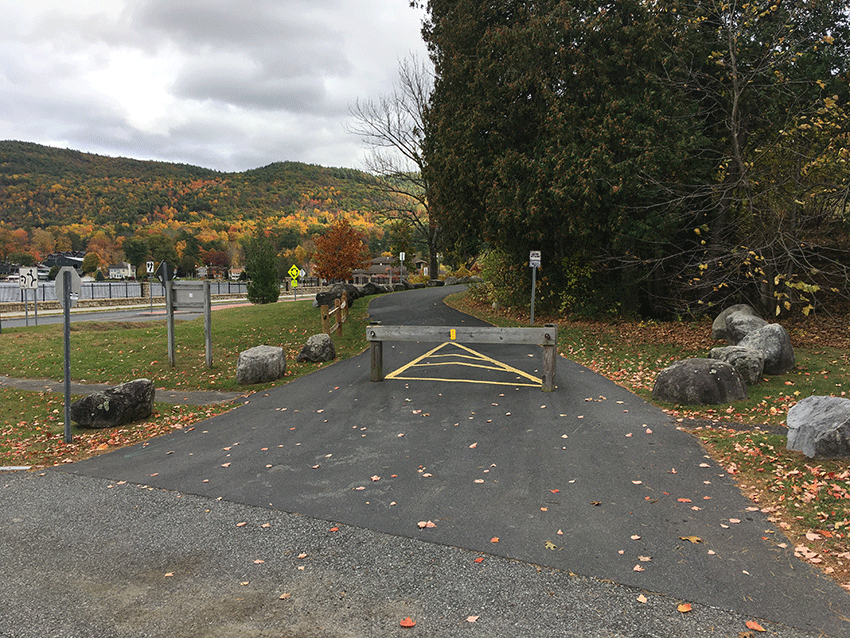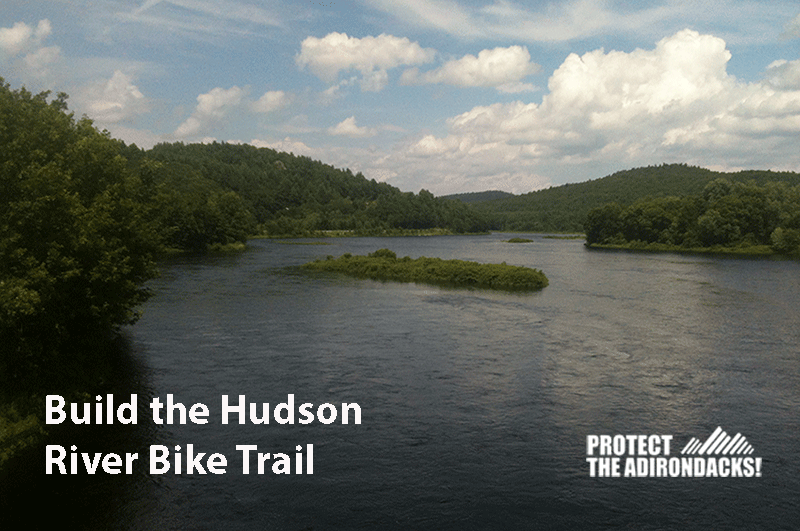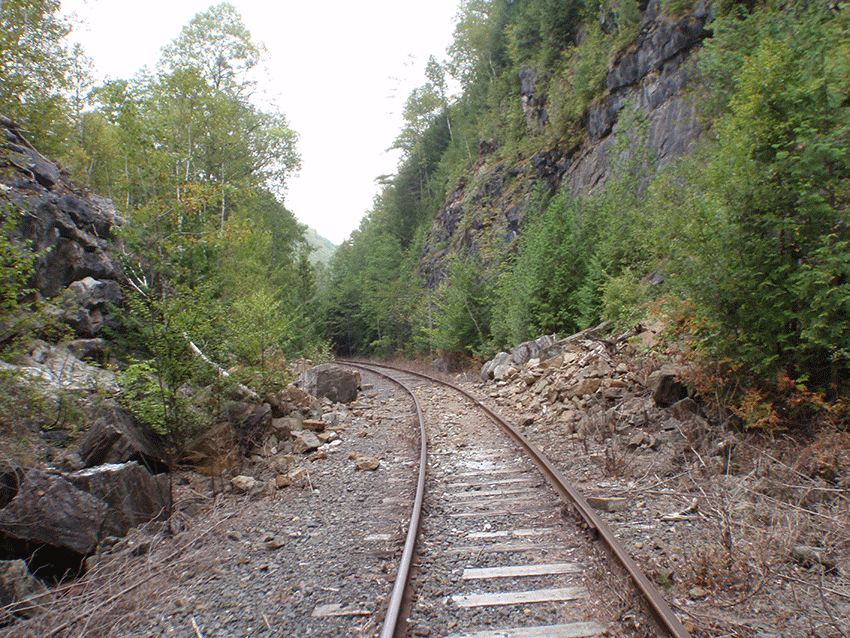It’s time to build the Hudson River Bike Trail.
A tremendous opportunity exists for the communities in the southern Adirondack Park to build what would be one of the great multi-use public recreation trails in New York and the eastern U.S. Protect the Adirondacks is advocating for the transition of the dormant 55-mile-long Saratoga and North Creek Railway to a public multiuse trail that would connect more than a dozen communities between Saratoga Springs and North Creek. More than 30 miles of this trail would be located along the Hudson River, where each bend in the river provides a different great view.
Protect the Adirondacks is advocating for state planning monies to conduct a public assessment about the viability of this new trail system. A new public trail from Saratoga Springs to North Creek would connect dozens of small communities such as Lake Luzerne, Stony Creek, Thurman, Riparius, The Glen, and Warrensburg, among other hamlets and businesses on the rail line. We believe that this new trail would be very popular and heavily used. It could stimulate new opportunities for communities and businesses up and down its route. Running on the banks of the Hudson River, this trail would delight as one of the loveliest public trail systems in New York, bringing people through scene after scene of wild natural beauty. From bases in Saratoga Springs or North Creek, bicyclists and walkers, among other users, would enjoy a stunning trip with long unbroken sections at the north end.
In an oddity of history, two separate and distinct railroads meet in North Creek. There is the 55-mile-long North Creek to Saratoga Railway that runs to the south and the 29-mile-long Tahawus Railway that runs from North Creek north to the Tahawus Mine in Newcomb. These two lines, though linked together, have separate histories and different current legal status.
Currently, the Saratoga and North Creek Railway corridor is owned by Warren County and the Town of Corinth. These municipalities own not only the rails, but the lands underneath them. They have previously leased the railroad to a private company, which unsuccessfully operated tourist and commuter trains. These efforts have all failed and the last rail company that held the lease defaulted and no new railroad company is currently interested in leasing the line.
The 29-mile Tahawus Railway runs north from North Creek along the Hudson and Boreas rivers, crossing over the Hudson River at one point, and is routed through extensive stretches of the public Forest Preserve lands. This rail line terminates at the Tahawus Mine in Newcomb. This rail line was created through an act of eminent domain by the federal government during World War II so that materials from the Newcomb mine could be hauled out expeditiously. The State of New York fought this action in court and lost. In this act, the federal government condemned a conservation easement for the operation of a rail corridor. In the early 1960s, this easement that was extended to 2062 and transferred to private ownership. There is a condition in the easement that if the railroad is abandoned then the lands in the railroad corridor will revert back to landowners, the largest being the State of New York through the public Forest Preserve.

A map of the two railroads that are currently dormant in Essex, Warren and Saratoga counties, running from Saratoga Springs to Newcomb.
The last railroad operator who leased the Saratoga and North Creek Railway had also purchased the Tahawus Railway easement in 2011 and tried to link the two railroads into one cohesive commercial enterprise. All business efforts failed. With its railroad ventures in the Adirondacks crumbling in 2017, the railroad company gambled on a controversial move to import used oil tanker railcars for indefinite storage on the Tahawus Railway. The company planned to store 2,000-3,000 used oil tankers on the empty tracks between North Creek and the Tahawus Mine in Newcomb. In 2017, over 100 oil tanker railcars that were transported into the Adirondacks for indefinite storage and were placed on tracks on the banks of the Opalescent and Boreas rivers. The section on the Boreas River was in the Forest Preserve. In 2017 and 2018, Protect the Adirondacks campaigned to stop long-term storage of used, out-of-service oil tankers on the Tahawus Railway. We publicized the many problems with this storage plan and our opposition work was featured in the New York Times. In partnership with local governments, Protect the Adirondacks produced a video opposing this plan.
In 2017, state agencies intervened to stop oil tanker railcar storage after Governor Andrew Cuomo announced his opposition to the plan. The last railcars were removed in 2018. Since the oil tankers were removed, the 29-mile Tahawus Railway has been dormant. The company has never figured out a viable or profitable way to haul materials from the Tahawus Mine in Newcomb.
To permanently stop the possibility of oil tanker railcar storage on the Tahawus Railway, the State of New York started formal “abandonment” proceedings at the federal Surface Transportation Board (STB). In October 2019, the NYS Attorney General submitted a letter to the STB formally requesting “voluntary abandonment” of the Tahawus Railroad. The state did so after reaching an agreement with the private company Iowa Pacific Railroad. The voluntary agreement accomplished three things. First, the voluntary agreement permanently prevents the rail line from being used for storage of railcars. Second, Iowa Pacific bought itself some good will with the state. The company is teetering on the edge of bankruptcy and is looking to sell its ownership of the Tahawus Railway corridor. Third, voluntary agreement will keep the rail corridor intact in the highly likely event that Iowa Pacific goes bankrupt, which would enable the possibility of converting the railway to a public multi-use public trail. It is expected that the STB will approve the voluntary abandonment.

The entrance to the Warren County Bike Trail that runs from Glens Falls to Lake George. This bike trail has been extremely successful and is a popular trail.
Right now, Warren County and the Town of Corinth own the Saratoga to North Creek Railway corridor and they have failed to find any railroad operator to lease this line. The future of the Tahawus Railway is clouded now in legal proceedings.
Now is the time to start planning for the future of this 85-mile rail corridor that runs to the heart of the central Adirondacks. Now is the time for local communities to begin the process of envisioning new uses for the railroads and to take a hard look at conversion of this railway to a multi-use public recreational trail. Now is the time for state intervention to bring this full rail corridor under public control.
The possibilities and benefits of a new recreation trail from Saratoga Springs to North Creek and then possibly north to Newcomb are immense. This trail would fast become a popular biking route for local cyclists and bike-riders from across New York and the Northeast USA. Many businesses along the railway would spring up and this public recreation trail would be a shot in the arm for the towns and hamlets along the way.
Protect the Adirondacks is working with local government leaders, businesses, volunteers from the general public, among others, to build support for a feasibility study of the conversion of the 55-mile-long Saratoga and North Creek Railway. It’s important to get good information about the current state of the rail line, the possibilities for conversion, and about the range of issues from possible uses, rate of use, conversion costs, maintenance, management, spillover uses into adjacent communities, protection for private residences along the trail, among many other issues. We believe that a vigorous public assessment process based on extensive public input should be organized to explore this proposal.
The idea of converting this rail line is an idea whose time has come. A transition will not be quick. This is a long-term investment to build a long-term asset for the region. It’s time to build the Hudson River Bike Trail.







